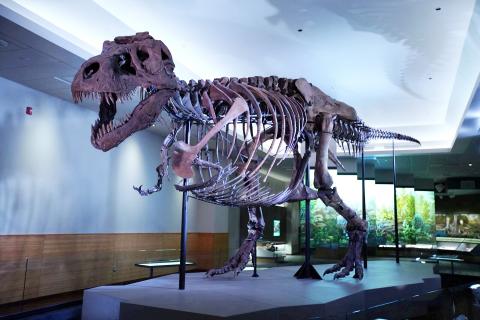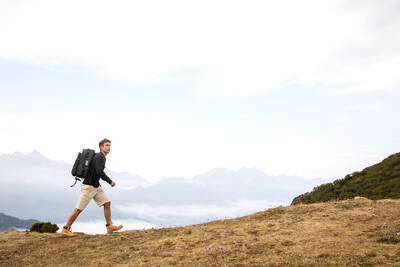Sue, the largest, most complete and best-preserved Tyrannosaurus rex ever unearthed, is showing off its new lair at the Field Museum in Chicago. The museum on Dec. 21 unveiled the 12.3m Sue, one of the world’s best-known dinosaur fossils, in the giant meat-eater’s new permanent exhibition space after 10 months of work moving and remounting the huge bones. Sue’s bones were mounted in a way that reflects new understanding about the species acquired over the past two decades.
One major change was the addition of gastralia, bones resembling an additional set of ribs spanning the belly that may have provided structural support to help the dinosaur breathe. “The gastralia form a basket of bones in the abdominal wall and really help us visualize the size and girth of Sue. We also adjusted the shoulder blades to fit with what we now consider to be the correct wishbone, and this had the effect of bringing the arms lower and closer to the midline. Sue can now clap,” said paleontologist Pete Makovicky, the museum’s associate curator of dinosaurs.
Sue is named after the American explorer Sue Hendrickson, who discovered the fossils in South Dakota in 1990. It is not clear whether the actual dinosaur was female or male. The museum bought the fossils at auction for US$8.4 million and put Sue on display in 2000. “Adjustments were also made to the ribcage and the right leg is less flexed. Finally, we gave the mount a slightly wider gape for dramatic effect,” Makovicky added. “The new exhibit is a smaller, more intimate space, so the sheer size of the skeleton comes across in a much more visceral way.”

Photo: Reuters
照片:路透
T. rex, one of the largest land predators ever, roamed western North America during the twilight of the age of dinosaurs during the Cretaceous Period, alongside horned dinosaurs, armored dinosaurs, duckbilled dinosaurs, flying reptiles called pterosaurs, birds with and without teeth and other creatures. An asteroid impact off the coast of Mexico 66 million years ago doomed the dinosaurs and many other land and sea creatures, though mammals survived the calamity and later became dominant.(Reuters)
目前挖掘到體型最大、最完整,保存狀況也最好的霸王龍「蘇」,最近在芝加哥的菲爾德博物館炫耀著牠的「新巢穴」。耗費十個月搬動巨大骨骼並重新組裝架起後,該博物館終於在十二月二十一日,於這隻巨型肉食獸的全新常設展覽空間中,為這具身長達十二‧三公尺、世界最知名的一組恐龍化石揭幕。「蘇」的骨骼組裝方式反映出過去二十年來科學家對這個物種獲得的新理解。
最主要的改變之一就是增加了腹部肋骨,宛如額外第二組肋骨,橫跨整塊腹部,可能提供結構上的支撐,協助這隻霸王龍呼吸。古生物學家暨菲爾德博物館恐龍類副研究員皮特‧馬科維契指出:「腹部肋骨在腹壁形成一個籃形的骨骼結構,這非常有助於我們視覺化『蘇』的體型大小和腹部周長。我們也調整了肩胛骨的位置,搭配今日咸認為正確的許願骨,這樣一來,手臂就會向下移,而且更貼近身體中線。『蘇』現在會拍手了。」
「蘇」的名字來自一九九○年在南達科他州發現這批化石的美國探險家蘇‧亨德里克森,不過科學家目前仍無法確定這隻恐龍實際上的性別為何。菲爾德博物館在一次拍賣會上以八百四十萬美元購得這批化石,並從二○○○年起開始展出「蘇」。馬科維契表示:「這次調整的部位還包括肋骨,也減少右腿的屈曲程度。最後,我們把化石骨架口部張開的程度稍微加大,增添一點戲劇感。」他進一步補充說:「新的展示廳是一個比較小、比較有親密感的空間,也因此整具骨骼純粹的巨大尺寸會迎面直撲而來,更發自內心產生衝擊感。」
霸王龍是體型最巨大的陸上掠食者之一,在恐龍時代的暮光中漫步於白堊紀的北美洲西部,伴隨著角龍類、甲龍類、鴨嘴龍類、被稱作翼龍的飛行性爬蟲類、有齒和無齒的鳥類以及其他動物。六千六百萬年前發生於墨西哥沿岸的一場小行星撞擊,為恐龍和其他各種陸上海中的生物敲響喪鐘。哺乳類動物則從這場大災難中倖存下來,隨後稱霸地球。
(台北時報章厚明譯)

★ Bilingual Story is a fictionalized account. 雙語故事部分內容純屬虛構。 “Get in. It’s pouring.” She slid into the back seat, drenched and silent. “Tissues?” the driver asked. “No, thank you,” she said. Water beaded off her hair, ran from her coat, and made a small lake on the vinyl. She kept her head down, long black strands clinging to her face. “Where to?” She gave an address. “Funeral?” he asked as they slipped into the Xinhai Tunnel, rain fading to a hollow drum. She glanced up, puzzled. “No. Why?” “Crematorium’s about the only thing here.” He caught her eyes in the mirror.

Have you ever dreamed of hiking Taiwan’s majestic Mt. Jade or visiting Peru’s breathtaking Machu Picchu? These adventures sound amazing, but there’s something you should know about first: “altitude sickness.” This condition strikes when you climb to a higher elevation too quickly. The higher you go, the thinner the air becomes, making it harder for your body to absorb oxygen. The symptoms usually begin within hours of reaching high altitudes — about 2,500 meters or higher. You might experience headaches, dizziness, nausea, shortness of breath, or extreme fatigue. These symptoms can last for several days. The severity of altitude sickness varies

Week 24 詞法—名詞 1. 人們一致稱讚他。 ˇ People praised him unanimously. χ Peoples praised him unanimously. 註:people 作「人們」(= men and women)解時,是單數形式,作複數用。peoples 是「多個民族」、「各國人民」,不是「多數人」,如 the peoples of Asia(亞洲各民族、亞洲人民)。 2. 她為他做了一條新褲子。 ˇ She made him a new pair of trousers. χ She made him a new trousers. 註:scissors 和 trousers 等名詞習慣用複數形式。「一把剪刀」或「一條褲子」正統說法為 a pair of scissors 或 a pair of trousers。 3. 我們提前兩年完成了第二個五年計劃的主要目標。 ˇ We fulfilled the major objectives of the Second Five-Year Plan two years ahead. χ We fulfilled the major objectives of the Second Five-Years Plan two years ahead. 註:five-year 作為一個複合形容詞,year 不用複數。又如 a twelve-year-old boy、a five-dollar note、a one-hundred-meter race 等,也是一樣。 4. 他們決定買一輛新車。 ˇ They have made up their minds to buy a new car. χ

Continued from yesterday(延續自昨日) https://www.taipeitimes.com/News/lang Interestingly, one of the words Collins Dictionary discarded was selected by Oxford University Press (OUP) for its own Word of the Year. On its Web site, the publishing house of the University of Oxford stated it had conducted a public poll in which over 37,000 people participated. The voters, along with OUP’s language experts, settled on the term “brain rot.” One main reason for the decision was the vast amount of interest in the noun during 2023 and 2024, with its usage increasing by 230 percent. In fact, brain rot is not a new term by any